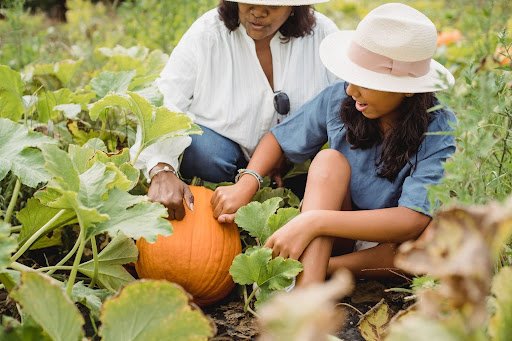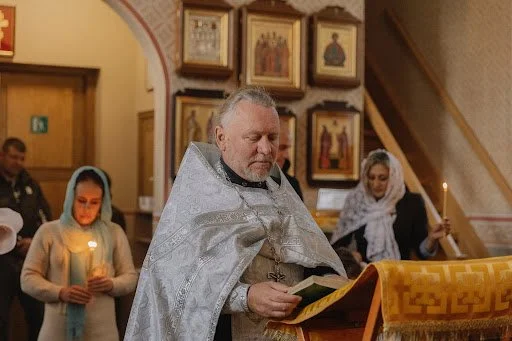Transforming Thanksgiving 2023: Applying a Critical Lens to the Past and Making New Memories with Cross-Cultural Harvest Celebrations
Image Description: Two women wearing light-colored fedoras sit on the ground and examine a pumpkin still connected to the pumpkin plant.
By Marion Davis
November has begun. With it comes many preparations for the fourth Thursday of the month. But should your organization celebrate Thanksgiving at all when the fourth Thursday is also the National Day of Mourning dedicated to raising awareness about indigenous history and dispelling the myths behind the Thanksgiving story?
This article will address this complex topic with a suggestion for an approach that allows both for a more accurate remembrance of a day with a dark history behind it as well as a way to create an inclusive celebration of gratitude as we near the end of the year. This approach involves corporations observing the fourth Thursday as a National Day of Mourning and using the opportunity to elevate Native American voices to speak on indigenous history. Additionally, this approach involves the creation of a cross-cultural harvest festival celebration on another day in November in recognition of the many harvest festivals held around the world and of traditional celebrations that stem from showing gratitude for the hard work that led to a bountiful year.
Transforming Thanksgiving within an Organization
In recognizing the multifaceted nature of the history of Thanksgiving, organizations can promote educational initiatives that explore the narratives of Native American communities. By doing so, celebrations can move beyond a simplistic portrayal of the Thanksgiving holiday and engage in meaningful conversations about reconciliation, justice, and the importance of preserving diverse cultural narratives.
In addition, the global context of harvest celebrations provides an opportunity for cross-cultural dialogue. Understanding similar traditions worldwide allows for the appreciation of shared values, emphasizing the importance of gratitude, community, and the harvest's significance in different cultures. This interconnected perspective promotes empathy and unity, encouraging individuals to celebrate the richness of human experience while acknowledging the complexities that shape our collective history.
In essence, by critically examining the history of Thanksgiving and drawing parallels with global harvest celebrations, organizations can play a pivotal role in promoting a more inclusive, informed, and culturally sensitive approach to this holiday. This approach creates an environment where diverse voices are heard, history is understood in its entirety, and Thanksgiving becomes a platform for dialogue, reflection, and unity across communities.
The History of Thanksgiving Celebrations in the US
While some people may be resistant to any changes to the celebration of Thanksgiving from celebrating the day on the fourth Thursday to creating depictions of Pilgrims in black and white, history shows that Thanksgiving in the US has meant many things to many different people over the years. In fact, less than a century ago, people celebrated Thanksgiving on the final Thursday rather than the fourth Thursday of the month. It took an Act of Congress at the time to mandate the change.
In more recent years, there has been a push for the general public to observe Thanksgiving as a day of remembrance. The feast that the Native Americans and the English settlers shared was a tiny moment of peace surrounded before and after by treaty violations, conflict, and bloodshed that led to the continued mistreatment of Native Americans to this day.
For the history of how the national holiday came to be: after a pivotal Union win during the US Civil War in 1863, Abraham Lincoln announced that November 26, 1863, was to be recognized as a national Thanksgiving holiday. This act recognized an idea that George Washington had initially proposed in 1789 but never came to fruition of recognizing the role of providence in the settlers seeking freedom as a colony from the English.
On November 23, 1939, Franklin D. Roosevelt carved a turkey for Thanksgiving on the fourth Thursday of the month in Warm Springs, Georgia. Across the nation, people were outraged as many states had long celebrated Thanksgiving on the last Thursday of the month and 1939 was a five-Thursday month. However, considering that many people did not begin shopping for Christmas gifts until after Thanksgiving, large corporations approached the president and asked that Thanksgiving be moved forward to the fourth Thursday from the final Thursday for a five-Thursday month so that the shops would have time to make more sales. Notably, small business owners were concerned that this change would negatively affect them. Roosevelt agreed to the requests of the large corporations. His act of carving a turkey in Georgia led to such outrage and refusal from many states to celebrate Thanksgiving on the fourth Thursday rather than final Thursday that Congress stepped in with an official act making the fourth Thursday the national holiday.
Many people assign great levels of nostalgia to observing Thanksgiving on the fourth Thursday of the month. However, notably, the observation of Thanksgiving on this Thursday has been in practice for less than a century, was motivated by large corporations wanting to make the most of the holiday sales season, and was enforced by the government against the wishes of many people.
Applying a Critical Lens to the History of Thanksgiving and the Impact of Colonization
The history of Thanksgiving is commonly depicted in simple, nostalgic tones that obscure a more complex and critical narrative, particularly when examining the interactions between the Wampanoag and the English. While the classic portrayal of Thanksgiving celebrations perpetuates a comforting myth, a closer examination of historical events reveals a nuanced story marked by broken treaties, injustices, and the consequences of colonization.
The history of Thanksgiving is linked in popular depictions to the arrival of the Mayflower in 1620, carrying English Separatists who were seeking religious freedom. The idyllic image of Pilgrims and Native Americans peacefully sharing a bountiful feast has become an enduring symbol of unity and cooperation. However, this depiction glosses over the harsh realities faced by the Wampanoag, whose generosity was met with the insidious encroachment of European settlers.
The initial encounters between the Wampanoag and the English were characterized by a tentative alliance born out of mutual necessity. The Wampanoag, led by figures like Squanto and Massasoit, offered crucial assistance to the struggling Pilgrims, providing them with agricultural knowledge and forging alliances.
The three-day Thanksgiving celebration offered a short respite from injustices that had taken place against the Native Americans of New England by the English settlers and of injustices that would soon resume in the future. Squanto himself was a member of the Pawtuxet tribe and had been taken captive by John Smith’s men in 1614-1615 and sent to England for a life of slavery. Squanto escaped and returned home to find that most of his tribe had been decimated by disease introduced by the English. Despite this horrific experience, Squanto used the language skills he had acquired during captivity to help the men, women, and children who had arrived in New England on the Mayflower and lacked the farming abilities to support their own survival on the land.
Following the Thanksgiving discussions, the narrative soon took a darker turn as the English settlers grew in number and their demands on Wampanoag resources increased. The history of Thanksgiving cannot be separated from the broader context of European colonialism, marked by the exploitation of indigenous lands and resources and of broken treaties leading to bloodshed in King Philip’s War and other conflicts.
As people in the US revisit the history of Thanksgiving this year, it becomes crucial to adopt a critical lens that goes beyond the picturesque imagery. Acknowledging the complexities of the interactions between the Wampanoag and the English allows for critical evaluators of the situation to confront the uncomfortable truths of colonization. The feel-good narrative of a harmonious Thanksgiving celebration should not serve as a shield against the nuanced realities of history, but rather as an invitation to explore the dynamics that shaped the relationships between the settlers and the indigenous peoples.
Drawing Parallels with Global Harvest Celebrations
Around the world, numerous countries and communities celebrate harvest festivals that emphasize community and gratitude and play a large part in religion and culture. These various celebrations create an excellent opportunity for employees of diverse backgrounds to use Thanksgiving as a company holiday where they can learn about celebrations around the world and in communities across the US as well as share their own cultures and cuisines as they feel comfortable.
Countries with Harvest Celebrations
The following is a list of a few examples of harvest festivals celebrated around the world:
China - The Mid-Autumn Festival (Moon Festival) is celebrated to give thanks for the harvest and is characterized by moon-viewing activities. It usually takes place in September or October.
Vietnam - Tết Trung Thu (Mid-Autumn Festival) is a time for family reunions, lantern parades, and mooncake sharing and is celebrated in September.
Japan - Tsukimi (Moon-viewing Festival) is a time to appreciate the full moon and offer gratitude for the harvest. Typically celebrated in September or October.
India - Various harvest festivals are celebrated, such as Pongal (January), Makar Sankranti (January), Onam (August or September), each marking the end of the harvest season in different regions.
Iran - Mehregan in October is an ancient Persian festival celebrating the autumn harvest with feasts and cultural events.
Israel - Sukkot (Feast of Tabernacles) in September or October is a biblical Jewish holiday commemorating the harvest and dwelling in temporary shelters.
Turkey - Seker Bayrami (Sugar Feast) follows Ramadan, with celebrations marked by feasting and sharing sweets. The date varies based on the lunar calendar.
Nigeria - The New Yam Festival, often celebrated in August or September, marks the end of the rainy season and the beginning of the harvest season in various ethnic groups.
South Korea - Chuseok in August or September, depending on the lunar calendar, is a major traditional harvest festival with family gatherings, ancestral rites, and feasting.
United Kingdom - Michaelmas, celebrated on September 29th, is a Christian festival marking the feast of St. Michael and All Angels. In some traditions, it is associated with the harvest season and the beginning of autumn.
Creating an Inclusive, Informed, and Culturally Sensitive Thanksgiving Celebration in the Workplace
To transform Thanksgiving celebrations in the workplace, organizations can take proactive steps. This includes promoting educational initiatives that explore the narratives of Native American communities, shedding light on their cultural heritage and on the true history surrounding the conflicts that occurred after the English settlers arrived on the continent. By embracing a broader perspective on Thanksgiving, companies can move beyond stereotypical portrayals of Pilgrims feasting peacefully with Native Americans and engage in meaningful conversations about reconciliation, justice, and the preservation of diverse cultural narratives.
Additionally, the global context of harvest celebrations offers an opportunity for cross-cultural dialogue. Understanding traditions worldwide allows for the appreciation of shared values, emphasizing gratitude, community, and the harvest's significance in different cultures. This interconnected perspective promotes empathy and unity, creating an environment where diverse voices are heard, and Thanksgiving becomes a platform for dialogue, reflection, and unity across communities.
The focus on a harvest celebration in many religions and cultures is an opportunity to show gratitude and enjoy the bounty of one’s work within a community. The focus of a cross-cultural celebration could likewise emphasize this theme as leaders within an organization take the opportunity to show gratitude for the hard work of their employees over the year and of recognizing the successes achieved by a diverse workforce.
Practical Steps to Transform Thanksgiving Celebrations in the Workplace
The following steps to transform Thanksgiving separate the day into an observation of the National Day of Mourning on the fourth Thursday of November to recognize indigenous history alongside a separate date in November for a day of gratitude with cross-cultural celebration of the many harvest holidays from around the world.
Learning an Accurate History to Observe the National Day of Mourning
The National Education Association has worked with Native American educators to outline several ways that organizations can create accurate and respectful celebrations while still observing Thanksgiving and benefitting from a holiday focused on gratitude. Corporations can use this same educational focus to guide them in observing the National Day of Mourning and dedicating this day to Native American voices.
Steps to observing a National Day of Mourning can include:
Using correct terms for both parties involved. Refer to the Pilgrims as the English or the Separatists. Rather than use the term “Indian,” refer to who specifically was there: the Wampanoag.
Providing information on the history of the Wampanoag, their contribution to helping the English survive, and their current-day status as 4,000 to 5,000 Wampanoag still live in New England today.
Researching Native American tribes local to the company’s region in the United States and hire a Native American educator to provide lessons at your organization on indigenous history, language, and customs.
Learning the true history of Thanksgiving as an event that lasted for three days and was focused on the Wampanoag and the English discussing political alliances, leadership, and peace after the Wampanoag had provided food to the English and taught the English the skills needed to survive on the land. The agreements established that day were soon broken as the English continued to mistreat the Wampanoag and encroach upon their land, leading to King Philip’s War.
Making Current Cross-Cultural Memories
Many of the employees at an organization may have their own unique approaches to celebrating Thanksgiving based on their backgrounds or may celebrate traditional harvest holidays. Rather than committing to the fourth Thursday of the month for Thanksgiving celebrations, celebration organizers can choose a date that works best for all employees within the organization to celebrate a communal harvest holiday.
Steps to create a cross-cultural celebration can include:
Setting up a survey for employees to vote on which day they would like to celebrate the holiday and what traditional dishes they would like to bring. This can range from differences in US Thanksgiving cuisine from the American South to New England as well as include dishes from other harvest holidays around the world such as Chuseok.
Creating a streamlined way to record and show ingredients for all dishes brought to the celebration so that employees with health, cultural, religious, or other dietary needs can partake in the feast easily.
Recognizing the contributions of the organization’s diverse workforce throughout the year. The focus of many harvest holidays is gratitude and to enjoy the bounty of one’s work. Leaders in the organization can use the cross-cultural celebrations as an opportunity to highlight successes achieved by the employees over 2023. Giving out employee recognition awards is one way to further memorialize this gratitude from leadership of the effort employees invested into supporting the organization's success. One article noted that 69 percent of employees would remain at their jobs if leadership expressed greater gratitude, recognition, and rewards for the employees’ contributions.
Final Thoughts
In all, transforming Thanksgiving within organizations requires a critical examination of the day’s history, acknowledging the complexities of the interactions between the Wampanoag and the English. By taking on a more accurate and nuanced understanding, companies can play a pivotal role in promoting a more inclusive, informed, and culturally sensitive approach to this holiday. Recognizing the National Day of Mourning on the fourth Thursday provides an opportunity to amplify Native American voices and shed light on their history, opening the door for meaningful conversations about reconciliation and justice. Simultaneously, creating a separate day for cross-cultural harvest celebrations allows for a global perspective, emphasizing shared values of gratitude and community across diverse backgrounds. As organizational leaders strive to make Thanksgiving a platform for dialogue, reflection, and unity, employees can embrace the richness of human experience and use this holiday as a catalyst for positive change within workplaces and communities.
Marion Davis is a contributing writer at EmployDiversityNetwork.com. She is a disabled DEIA consultant and writes on the value of diversity and inclusion across multiple industries, specifically as relates to disability and intersectionality.











